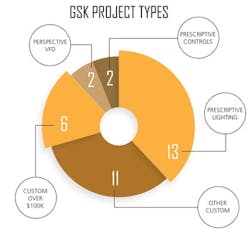Energy Efficiency Makeover Yields Utility Incentive Rewards
GlaxoSmithKline (GSK) is an industry leader in driving these reductions, establishing a corporate mandate to reduce CO2 emissions across its value chain below 2010 values — by 10 percent in 2015 and 25 percent by 2020. GSK operates two main R&D campuses and one production facility in southeastern Pennsylvania in addition to several other smaller support facilities. The total size of GSK R&D operations in Pennsylvania is just over 3 million square feet, employing about 6,000 people. In Pennsylvania, GSK’s reduction efforts dovetailed with the state’s own Act-129’s energy reduction mandates for commercial electricity providers, enabling GSK to leverage the regional energy service provider’s (ESP’s) Act-129 incentive program to accelerate the pace of these reductions. GSK is characterized as a commercial and industrial customer for the incentive program.
The Regional ESP has been implementing its energy efficiency and conservation plan (EE&C) by implementing incentive programs that reward energy efficiency improvements. The ESP’s programs offer financial incentives promoting the adaptation of energy efficient equipment including lighting, HVAC building systems, motors and drives as well as other eligible technologies and measures. Listed on the application as “prescriptive measures,” each item has a fixed incentive amount per unit allotted to their implementation. Measures not appearing on the incentive application form, if found eligible, could be applied as “custom” measures and incentivized at predetermined custom rates — 12 cents per kilowatt-hour (kWh) saved during on-peak hours and 8 cents per kWh saved during off-peak hours. On-peak hours consist of non-holiday weekday hours from noon to 8 p.m., Monday to Friday, June 1 through September 30. All other hours are classified as off-peak hours.
One of the basic elements of technical program oversight was provided by the Pennsylvania Public Utility Commission’s Technical Reference Manual (TRM), which describes the algorithms and factors used to calculate savings for energy efficiency measures. Measures not included in the TRM were considered “custom” and required extensive calculations and measurement and verification to determine savings. Similar incentive programs are offered by utilities around the nation. The main objective of these programs is to promote energy efficiency by offering incentives to the customers for undertaking energy efficiency projects.
In 2008 the Pennsylvania Assembly passed Act-129, which:
• Required utilities to develop and implement plans to encourage customer energy efficiency
• Authorized collection of an energy efficiency charge per kWh sold to support the programs
• Required the Pennsylvania Public Utility Commission to oversee the utility programs.
This initial program required an electric distribution company (EDC) with at least 100,000 customers to adopt an energy efficiency and conservation plan (EE&C plan), approved by the Commission. The goal of the program, by the end of Phase 1 of Act-129 program implementation was to:
• Reduce the total annual weather-normalized electric consumption by a minimum of 3 percent.
• Reduce peak demand by a minimum of 4.5 percent of the EDC’s annual system peak demand in the 100 hours of highest demand.
Also invited to help meet GSK’s energy efficiency goals was Johnson Controls, who provided the project management and energy engineering services necessary to oversee the building system, lighting and HVAC control implementations and retrofits. GSK also produced applications for certain projects where the engineering effort did not overburden the project manager (such as with prescriptive lighting applications). In order to maintain a single point of contact with the program administrator for coherent communications, all applications were submitted by Genesis, even those prepared by Johnson Controls or GSK.
HOW GSK’S PROGRAM WORKS
GSK reviews and executes hundreds of capital projects of widely varying sizes and scope each year. The first task in the process was to have the project’s participants meet with GSK’s project management staff to identify projects that include energy-conserving components likely eligible for incentives. When the effort started in May 2010, there were 37 active and pending projects identified as potentially being eligible for participation. Dozens more were added each year, but the initial backlog and retroactive implementation of Act 129 resulted in nearly half of GSK’s incentives being awarded in 2011.
Once identified as potentially qualifying, projects were screened for specific eligibility. Due to GSK’s aggressive energy conservation goals, incentives were typically pursued even for small projects with lower incentive values. Projects that lacked sufficient evidence to prove savings were dropped. As noted GSK’s team worked closely with the utility throughout the project selection process to assure the eligibility of selected projects and validate in advance the methodology for proving savings. Of the 34 incentives received:
• 17 were custom and 17 prescriptive
• Of the 17 prescriptive applications, 12 were lighting projects
• The 17 custom applications accounted for 90 percent of the value of incentives received
• Six applications of $100,000 or more accounted for 70 percent of the incentives received
• External administration and engineering cost approximately 15 percent of the incentive value, with the cost somewhat proportional to incentive value.
GSK is taking the significant return from its energy conservation efforts and reinvesting it in, among other things, its critical R&D efforts to discover new drugs in support of the company’s mission to help people “do more, feel better and live longer.” The incentives have also been used to assist in funding new energy reduction projects, which continue to control energy spending and related costs.
For GSK, the Act-129 incentive program initially provided unexpected benefits for projects that were already in progress prior to the inception of the program. Moving forward, incentive values are being incorporated into project planning and Act-129 is serving as a motivator, at times making the difference between an economically viable and non-viable project.
LESSONS LEARNED
A number of lessons were learned, which can assist in future project selection, project execution and incentive application:
• Quality measurement and verification (M&V) is critical. Proving energy savings requires accurate readings of both baseline and final energy use. None of the applications submitted on behalf of GSK involved direct reading of kWh, so proxy measurements were required. This typically included chiller, pump and fan kW readings, fan or room airflow readings and/or outside air and supply air temperature and humidity. Some energy conservation projects were started without taking pre-readings, resulting in an inability to prove savings and, therefore, a loss of energy conservation incentives.
• Engage project managers. A corporate-wide energy conservation mandate requires the active participation of all project execution personnel to achieve the highest savings and largest incentives possible. Project managers must be engaged early to ensure all projects with energy conservation potential are identified for incentive application, that baseline energy measurements are taken and that maximum performance is achieved from the energy conservation measures.
• Commissioning is critical for ensuring functionality. A detailed commissioning is required to ensure energy conservation measures function properly and trend data is accurately captured. This requires point-by-point verification and calibration of all sensors needed for measuring energy consumption, including verification of calculations performed by building automation systems. Often, building automation systems include simplified calculations that may not be accurate enough to prove energy savings, such as assumed voltage and power factor measurement.
• Include incentive value in payback calculations. Now that Act-129 has been extended for a second phase and the types of project and methods of proving savings have been validated, decision-makers can use the value of the incentives in payback calculations with confidence. Incentive value should not be used to reduce the project budget, as incentive payment is received after the project is finished and operational for long enough for savings to be proven.
The collaboration between GSK, Johnson Controls and Genesis has resulted in over $2 million worth of incentives to GSK between its southeastern Pennsylvania facilities, with 24 GWh of annual electric energy use reduction and 13.7 kTons of annual CO2 reduction (not including associated gas heating savings) for 34 energy-efficiency projects implemented during the Phase-1 of Act-129. GSK was one of the major participants in the Act-129 program and was placed on the ESP’s Top 5 list of participating customers in terms of kWh energy savings claimed and incentives received.
LAB VENTILATION OPTIMIZATION PROGRAM
GSK implemented a lab ventilation optimization program (LVOP) in its R&D facilities. One building at its Upper Providence campus houses approximately 54,000 square feet of lab space. Due to the optimization of the lab ventilation, a significant reduction in air flow through the facility was realized. Additional unoccupied mode reductions required installation of occupancy sensors, which were tied to the lighting and HVAC systems. The resulting energy savings yielded an energy reduction of over 3 million kWh per year for an incentive value of $256,000.
HEAT RECOVER CHILLER
Here, GSK installed a Dedicated Heat Recovery Chiller (DHRC) to provide simultaneous chilled and hot water in support of the laboratory environment that needs both cooling and reheat to maintain proper environmental conditions in the lab. The DHRC was sized to provide all of the reheat required for the building in the summer. Cooling output could be provided to the building or to the campus-wide chilled water system by reversing the flow through the main chilled water piping into the building, offsetting central plant chilled water. Reheat for the building was previously provided by a steam shell and tube heat exchanger and supportive/rate optional electric resistance boiler, under an electric heating rate rider. As a result, the DHRC displaced electrical load for both its heating and cooling. This saved GSK over three million kWh per year, for an incentive value of $251,000.
FUME HOOD REPLACEMENT
Another Upper Merion campus building houses R&D laboratories. Changing research and changing technology rendered existing fume hoods oversized and obsolete. Constant volume hoods in 11 laboratories were replaced with smaller VAV hoods with automatic sash closures and proximity sensors. The resulting savings was over two million kWh per year, for an incentive value of $180,000.
LIGHTING RETROFIT
GSK completed a number of lighting retrofit projects that received incentive payment due to the retrofitting of entire campuses from T12 to T8 lighting. The largest project was a multi-building retrofit in the Upper Merion campus in which nearly a thousand lamps were replaced. The total incentive value was $37,000.






